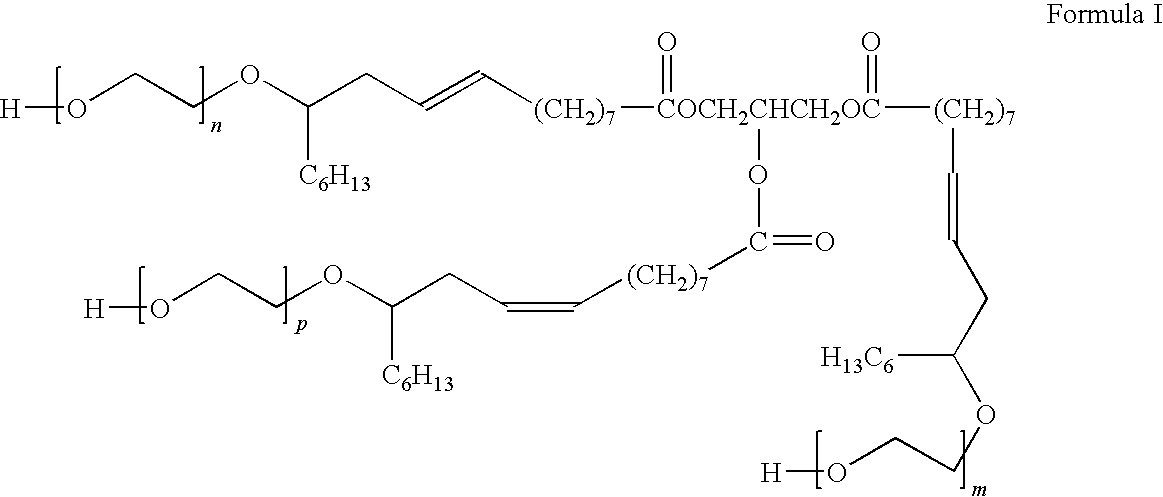Nanofiller-containing epoxy resins and stable aqueous dispersions thereof
- Summary
- Abstract
- Description
- Claims
- Application Information
AI Technical Summary
Benefits of technology
Problems solved by technology
Method used
Image
Examples
example 1
[0074]An 84 gram (g) sample of Nanopox C 450, a nanofiller-containing epoxy resin, was mixed with 16 g of XZ 92576.00, a low temperature nonionic surfactant, which is an epoxy modified polyethylene glycol and a proprietary material of The Dow Chemical Company. The mixture was blended in a metal beaker at 40° C. The resultant homogenous mixture was then mixed with a high speed stirrer at 2000 rpm and water was slowly added to the mixture at 40° C. until phase inversion occurred. The mixture was then stirred at 1000 rpm and water was added to the mixture until the desired solid content was achieved. Properties, such as EEW, solid content and volume average particle size, of the resultant stable dispersion were measured.
[0075]The particle size of the stable dispersion was measured with a Malvern Mastersizer 2000 and found to be: D[3.2]:0.457 microns. The EEW of the epoxy resin was measured by a Methrom Titroprocessor, Type 682 and found to be EEW: 631. The solid content of the stable d...
example 2
[0076]An 80.8 gram sample of Nanopox C 450, a nanofiller-containing epoxy resin, was mixed with 16.8 g of Hydropalat 3037, a low temperature nonionic surfactant, and 2.5 g of a anionic surfactant based on sodium dioctyl sulfosuccinate (Disponil SUS IC 875, available from Cognis); and blended in a metal beaker at 40° C. The homogenous mixture was then mixed with a high speed stirrer at 2000 rpm and water was slowly added to the mixture at 40° C. until phase inversion occurred. The mixture was then stirred at 1000 rpm and water was added to the mixture until the desired solid content was achieved. Properties, such as EEW, solid content and volume average particle size, of the resultant stable dispersion were measured.
[0077]The EEW of the epoxy resin was measured by a Methrom Titroprocessor and found to be EEW: 746. The solid content of the stable dispersion was found to be 54% as measured by a Sartorius Moisture Analyzer MA 45.
example 3
Preparation of Defect-Free Coatings: With Dispersible Resin
[0080]An 18 gram sample of Nanopox C 450, a nanofiller-containing epoxy resin, was mixed with 2 g of XZ 92576.00, a low temperature nonionic surfactant, which is an epoxy modified polyethylene glycol and a proprietary material of The Dow Chemical Company. This water-dispersible resin was then mixed with 18 grams of a hardener, Epilink® 701, and 10 grams of water. The mixture was then applied on a glass panel with a film applicator (120 microns wet) and cured at 23° C. and 50% humidity. The cured films were clear and showed no particles or agglomerates rated by visual assessment of the films on the glass substrate.
PUM
| Property | Measurement | Unit |
|---|---|---|
| Length | aaaaa | aaaaa |
| Percent by mass | aaaaa | aaaaa |
| Percent by mass | aaaaa | aaaaa |
Abstract
Description
Claims
Application Information
 Login to View More
Login to View More - R&D
- Intellectual Property
- Life Sciences
- Materials
- Tech Scout
- Unparalleled Data Quality
- Higher Quality Content
- 60% Fewer Hallucinations
Browse by: Latest US Patents, China's latest patents, Technical Efficacy Thesaurus, Application Domain, Technology Topic, Popular Technical Reports.
© 2025 PatSnap. All rights reserved.Legal|Privacy policy|Modern Slavery Act Transparency Statement|Sitemap|About US| Contact US: help@patsnap.com



